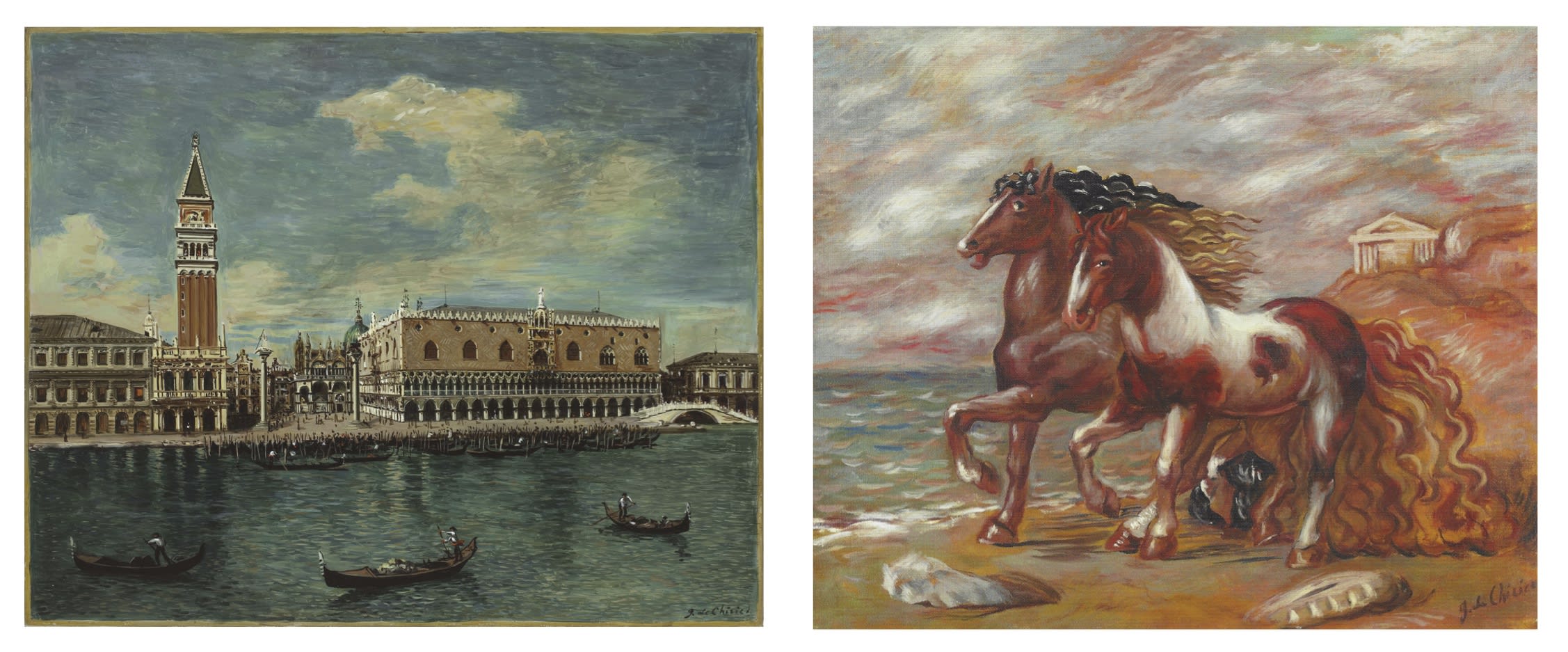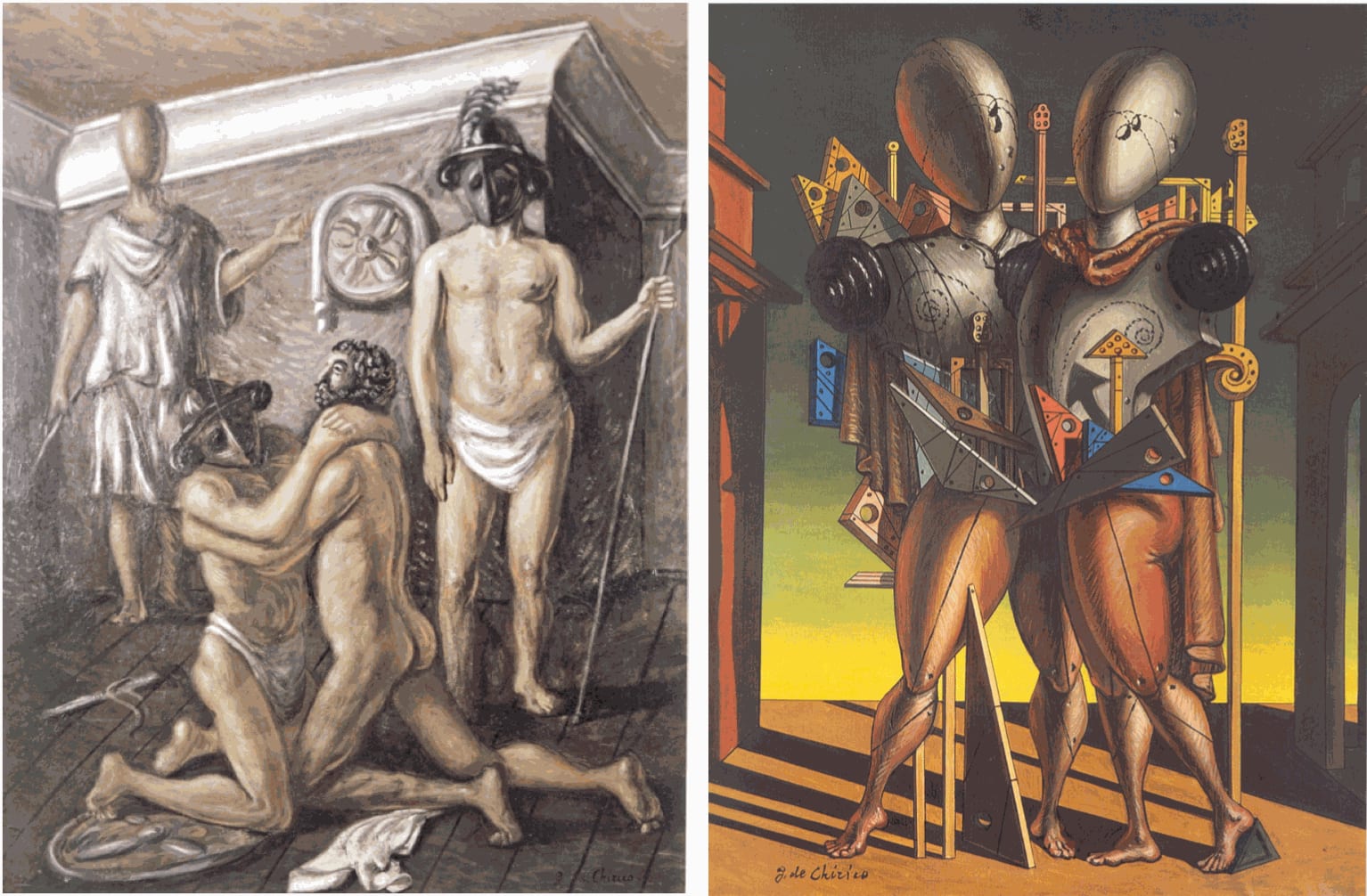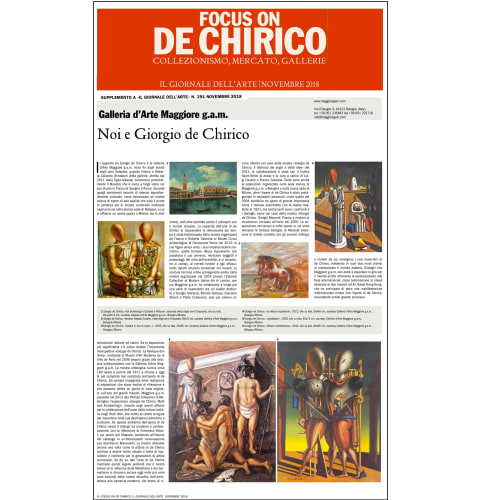The relationship between Giorgio de Chirico and Galleria d’Arte Maggiore g.a.m. began in the early 1970s, when Franco and Roberta Calarota—the gallery’s founders, whose daughter Alessia has directed it since 2011—met the Master in person. De Chirico invited them to visit him in his studio in Piazza di Spagna, Rome. During those friendly encounters, marked by deep cultural exchange, a substantial group of high-quality works was selected, becoming the foundation for curatorial exhibitions held over the years both in the gallery’s historic Bologna venue (later joined by a new space in Milan) and in major institutional contexts in Italy and abroad.
Among the most significant exhibitions stands the important retrospective Giorgio de Chirico. La fabrique des rêves, organized at the Musée d’Art Moderne de la Ville de Paris in 2009, made possible through decisive collaboration with Galleria d’Arte Maggiore g.a.m.
The anthological exhibition brought together around 160 works dating from 1911 onwards and remains to this day the most comprehensive show ever devoted to de Chirico’s oeuvre.
Constantly committed to organizing exhibitions that encourage reflection and offer original perspectives on the work of great masters, Maggiore g.a.m. presented in 2013 the exhibition Giorgio de Chirico. Myth and Archaeology at the Phillips Collection in Washington. Part of the official events celebrating the Year of Italian Culture in the United States, it focused on the figure of the mannequin in de Chirico’s painting and sculpture. From this central symbol in his work was born a dialogue between modern and contemporary art, with Francesco Vezzoli’s reflections on the Master’s legacy featured in the exhibition catalogue through an engaging conversation with Gianfranco Maraniello.
Once again, the show demonstrated how de Chirico’s art remains strikingly relevant, a constant source of inspiration and dialogue for later generations of artists. While his work maintains deep ties with our time—the influences of Metaphysical and Surrealist art can still be found today across multiple cultural spheres, from architecture to literature, theatre, and cinema—it also continues its dialogue with the classical world.

Giorgio de Chirico, Venezia. Palazzo Ducale, mid-1950s, 62x76 cm, courtesy Galleria d’Arte Maggiore g.a.m., Bologna/Milan;
Giorgio de Chirico, Cavalli in riva al mare, c. 1935, oil on canvas, 45x55 cm, courtesy Galleria d’Arte Maggiore g.a.m., Bologna/Milan
The timeless dimension of de Chirico’s art was further emphasized by the exhibition organized by Franco and Roberta Calarota at the Museo Civico Archeologico in Chianciano Terme in 2012. His faceless figures, inscrutable mannequins, and the famous Disquieting Muses that populate his universe recall the myths and characters of antiquity, placed in dialogue with the canopic jars, funerary objects, and fascinating Etruscan artifacts preserved in the museum.
Sculpture once again took center stage in the 2014 exhibition at the Estorick Collection of Modern Italian Art in London, where Maggiore g.a.m. has long collaborated on a series of exhibitions, including those dedicated to Giorgio Morandi, Renato Guttuso, Giacomo Manzù, and Pablo Echaurren, among others.
In the case of the exhibition Giorgio de Chirico. Il labirinto dei sogni e delle idee (2012), the gallery collaborated with the Saint-Bénin Center in Aosta, under the curatorship of Luigi Cavallo and Franco Calarota.
Numerous exhibitions have also been organized at Maggiore g.a.m.’s historic Bologna venue and at its Milan space, where de Chirico’s work has often been featured in solo shows—such as the 2004 exhibition, which included major works like the famous Self-portrait with Mother (1921). Many have also explored artistic dialogues, such as Giorgio de Chirico. Giorgio Morandi. Poetry and Mystery Meet, held in the early 2000s.
The sense of suspension in time and space that envelops Morandi’s famous bottles entered into direct dialogue with the enigmatic, motionless scenes from which de Chirico’s mannequins emerge, highlighting two distinct ways of internalizing the external world.
These artistic conversations are also carried around the world through Maggiore g.a.m.’s participation in international art fairs, as demonstrated by the stand dedicated to both masters at Art Basel Hong Kong—an event that preceded a major Chinese exhibition featuring de Chirico’s work and was met with great success.

Giorgio de Chirico, I gladiatori, 1928, oil on canvas, 92x73 cm, courtesy Galleria d’Arte Maggiore g.a.m., Bologna/Milan;
Giorgio de Chirico, Ettore e Andromaca, 1942, oil on canvas, 80x60 cm, courtesy Galleria d’Arte Maggiore g.a.m., Bologna/Milan





